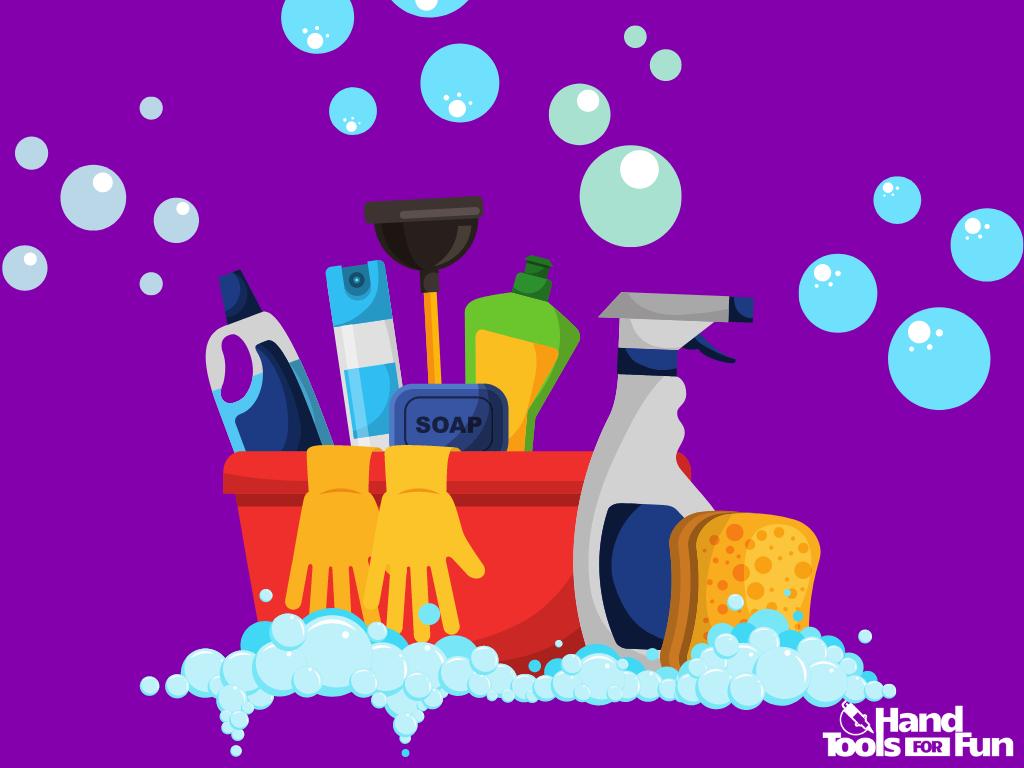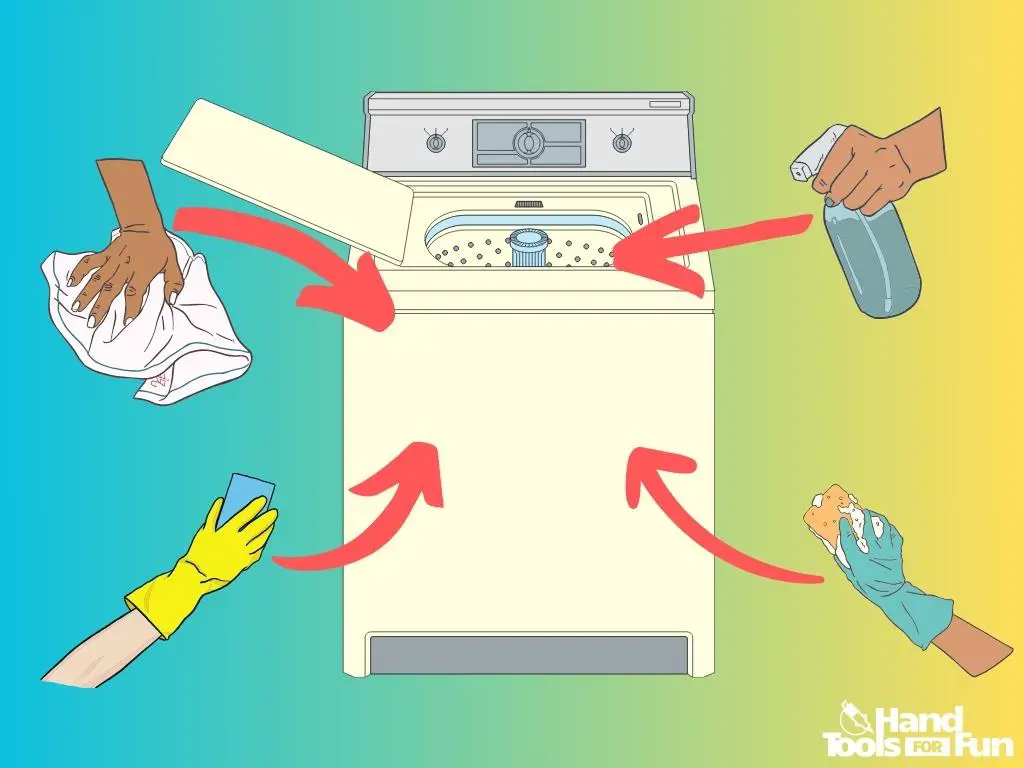Maintaining a clean and efficient home extends beyond the visible surfaces to the appliances we rely on daily.
A top-loading washing machine is a stalwart companion in keeping our attire pristine, but it too requires regular care to perform at its best.
As DIYers and homeowners alike, who cherish the art of home maintenance, we recognize the importance of a well-cleaned machine—not only for garment care but also for extending the lifespan of the appliance.
This guide seeks to empower you with the techniques and knowledge needed to transform your top-loader into a bastion of cleanliness.
With just a few simple supplies like white vinegar, baking soda, and a soft touch, we’ll dive into the satisfying process of rejuvenating your faithful washing machine.

Gather Cleaning Supplies
Keep Your Washing Machine Sparkling: Safe Cleaning Agents for a Fresh Laundry Experience!
When it comes to keeping a washing machine clean and functioning at its best, using the right cleaning agents is crucial.
A well-maintained machine not only ensures clothes come out fresh and clean but also extends the life of the appliance.
So, let’s dive into what cleaning agents should be on your go-to list for keeping your washing machine in tip-top shape without causing any harm!
1. Distilled White Vinegar
Distilled white vinegar is a dream when it comes to household cleaning, and your washing machine is no exception.
This natural descaling agent works wonders in removing soap scum and mineral build-up from hard water.
Simply pour a cup of vinegar into the drum and run a hot water cycle. It’s biodegradable and won’t create any foam, which is perfect for the washer’s health.
2. Baking Soda
Known for its deodorizing properties, baking soda makes a great partner to vinegar during cleaning.
After running a vinegar cycle, sprinkle half a cup of baking soda directly into the drum and run a short cycle with hot water.
It not only helps in removing odors but also scrubs away any lingering residue without being abrasive.
3. Hydrogen Peroxide
Hydrogen peroxide (3% solution) can be an excellent ally due to its disinfecting properties. If you’re looking to give your washing machine a germ-free cleanse, add a couple of cups of hydrogen peroxide into the empty drum and run a hot-wash cycle.
It’ll tackle bacteria and give your machine a refreshing cleanse – especially valuable during flu season or after washing heavily soiled items.
4. Lemon Juice
For those seeking a fresh scent and a natural acid to combat buildup, look no further than lemon juice. It’s superb at targeting limescale and mildew.
Add a cup to the detergent tray and combine with a hot wash cycle for the best results. Plus, your machine will have that citrus-fresh aroma.
5. Washer Cleaners
Commercially available washing machine cleaners are formulated to clean specific areas in the washer that other agents might miss.
They often come in tablet or liquid form and are easy to use – just follow the instructions on the package. Opt for fragrance-free and dye-free options to avoid any potential irritants.
6. Mild Detergent
Occasionally, a mild liquid detergent with a low sudsing profile (often labeled as ‘HE’ for high-efficiency machines) can be used for regular upkeep.
Run a normal cycle with hot water, and that should do the trick for a light cleanse.
Narrowing Down the “Don’ts”!
While we’re discussing what’s safe, it’s just as important to mention what to avoid. Bleach should be used with caution as overuse can damage seals and other components.
Never mix cleaning agents, like vinegar and bleach, the reaction could be harmful. Additionally, steer clear of abrasive powders, they can scratch and damage the drum.
A clean washer leads to clean laundry, and taking the correct steps to maintain your appliance doesn’t have to be complicated.
Using these safe and effective cleaning agents will help ensure your washing machine runs efficiently and reliably, wash after wash.

Run a Hot Water Cycle
A Fresh Spin: Using Hot Water and Vinegar to Clean Your Washing Machine
Washing machines tirelessly work to keep our clothes sparkling clean, but let’s not forget, they need a good scrubbing too!
Of course, you already understand the importance of descaling and keeping your machine free of odor and residue with the tried-and-true helpers like white vinegar, baking soda, and sometimes a touch of lemon juice.
But let’s dive into the nitty-gritty of a hot water cycle with vinegar, a simple yet brilliant method to maintain that fresh, clean efficiency.
Here’s the procedure:
- Set the Stage: Begin by ensuring your washing machine is empty. Remove any items that might be lounging in the drum or pockets of clothing forgotten in prior loads.
- Temperature Matters: Select the hottest water setting available on your machine. This high temperature is crucial as it aids in dissolving residue and allows the vinegar to work its magic more effectively.
- Vinegar, the Star: Measure out two cups of distilled white vinegar. Pour it directly into the detergent dispenser of your washing machine. If your machine doesn’t have a dispenser, you can pour the vinegar directly into the drum.
- Start the Cycle: Initiate a long wash cycle. The aim here is to give the vinegar ample time to interact with any grime and mineral build-up in your drum or pipes.
- Pause for Effect: Halfway through the cycle, pause your washing machine and let the hot vinegar water sit for an hour. This soaking period gives an extra punch, breaking down any stubborn build-up.
- Resume and Complete: After the soaking time, resume the cycle and let it finish. The hot water and vinegar will work in tandem, rinsing away grime, bacteria, and any moldy smells as it completes its cycle.
- Wipe Down the Details: Once the cycle has ended, don’t forget to wipe down the inside of the drum, and any crevices, including the door gasket and the detergent dispenser. Use a clean cloth or sponge dampened with a little vinegar to make sure you’re hitting all the right spots.
- Air it Out: Finally, leave the door open allowing air to circulate, which helps in preventing mold and mildew from setting up residence in your cleaned machine.
By now, the virtues of your trusty vinegar have worked to spruce up your washing machine, leaving it sparkling clean and functioning at its best.
Regular maintenance, by running a hot water cycle with vinegar, can go a long way in extending the life and efficiency of your household helper. Happy laundering!
Clean Washer Interior and Exterior
Now, let’s dive deeper into the lesser-discussed areas of your washing machine that hold the secret to maintaining the machine’s hygiene and performance.
The Rubber Gasket:
That rubber seal around the door on a front loader, also known as the gasket, is a hotbed for moisture and can become a breeding ground for mold and mildew.
Carefully pull back the gasket and wipe underneath as well as around it using a soft cloth dampened with a solution of water and mild detergent or your hydrogen peroxide mixture. Make sure to dry it thoroughly after.
Dispenser Drawers:
Detergent and fabric softener dispensers often go unnoticed, yet they can accumulate residue and sticky build-up.
Remove these drawers and soak them in hot, soapy water. Use an old toothbrush to scrub away any residue.
For stubborn spots, sprinkle a bit of baking soda before scrubbing. Rinse well and let them dry before putting them back in place.
The Drain Pump Filter:
Yes, machines have filters too, and they can get clogged with small items and lint. This might not be a daily task, but periodically, these filters require attention.
Locate your machine’s filter—usually at the front lower part of the washer. Have a towel and a shallow pan ready for water that might escape. Open it, remove any debris, and rinse it out.
The Interior Drum:
Even though you’ve run a hot water and vinegar cycle, a manual touch won’t hurt. After the cycle, dip a microfiber cloth in your vinegar solution and give the inside of the drum a good wipe down. Pay special attention to the top, an area where detergent can splash and accumulate.
External Surfaces:
Lastly, don’t neglect the exterior. Wipe down the top and sides of your machine with a cloth dipped in your diluted vinegar solution or mild detergent. Also, keep an eye on the control panel for any build-up from grimy hands.

Remember, your washing machine is a workhorse, but even workhorses need grooming to look and perform at their best.
The effort put into these overlooked spots will make your next laundry endeavor not just a cleaner one, but one that often translates into longevity and efficiency for one of your most used appliances.
Make it a part of your cleaning routine, and the results will surely spin in your favor.
Embracing the role of an at-home appliance whisperer not only elevates your laundry routine but also instills a sense of pride in your household management skills.
The sheen of a freshly cleaned washer reflects the care and attention invested into preserving its operational excellence.
Equipped now with the know-how to keep your top-loading machine in tip-top shape, you may find the task becoming less of a chore and more of a cherished ritual.
As with all good maintenance practices, consistency is key, so mark your calendar for the next cleaning session and bask in the peace of mind that comes from a well-maintained home.


